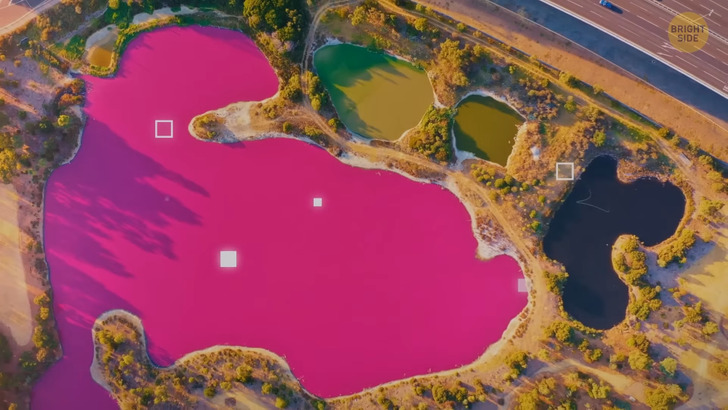My Coworker Reports Everyone to HR to Get Bonuses—So I Turned the Tables


You’re walking along a hot desert under the scorching sun. You run out of supplies, there is no more water. You dream about rain, but there are no clouds in the sky. With each step, you lose more and more strength and... fall. You notice a small pond nearby. Is it real water or just a mirage?
You can’t get to your feet, so you crawl there. The water is getting closer by the minute, but not because you’re moving towards it. It’s the water approaching you. In a few minutes, the pond area increases. Here, you’re already in it. A small lake has formed, 60 feet deep, at the place where the piece of the desert was.

This real event happened in 2014 in the Tunisian desert. No one knows exactly on what day the lake appeared since this part of the south of Tunisia is sparsely populated. At first, shepherds passing by saw the lake and didn’t believe their eyes. In the next few hours, hundreds of locals came running to the place. They began to swim, jumping into the water from the surrounding rocks. But a few days later, something strange happened to the lake. In the beginning, it was a crystal clear, turquoise-blue color. But then it turned dark green. People didn’t attach any importance to this and continued to swim. They shouldn’t have done that.
The scientists and geologists arrived and immediately announced that it wasn’t safe to swim in the lake. Muddy green water means the lake is stagnating. It’s not refreshed, it’s not fed by underground springs. Now the lake is filled with algae and a lot of harmful bacteria that can cause serious diseases. They also found out that this region of Tunisia is filled with huge deposits of phosphate. This substance can disintegrate and leave radioactive traces. The lake can be carcinogenic, toxic, and hazardous for any living organism.
But people didn’t worry about this too much. They walk in the middle of the desert, while the sun heats the air to 104 °F. Most of them are unlikely to refuse to jump into cool water, despite the warnings of scientists. Until now, no one knows exactly the reason for the appearance of the lake. Some scientists believe the lake was formed because of heavy rains. The lake is surrounded by rocks and is located inside a canyon. The water could just accumulate after each storm.

Some geologists think an earthquake was the cause of the lake. A small seismic activity provoked the rupture of the earth’s rock above the water table. And through this hole, all the water splashed out. And if this theory is correct, then the lake can be pulled back underground through cracks. This is the same as when you pull the plug out of the drain hole in a filled bathtub. Any small earthquake is like pulling the plug out. Therefore, if you find yourself in these places, don’t swim in this radioactive lake.
We’re going to the Caribbean islands region. Among the clear blue sea, you can find a unique lake. It’s located on one of the paradisiacal islands. You may not even notice the lake right away. The entire territory may seem like a huge concrete platform. But the main thing is not to step on its surface. Pitch Lake is a lake filled not with water, but with liquid asphalt. This is the largest asphalt deposit in the world. Steam is coming from all over the lake, as it’s hot. The depth of the lake is 250 feet. An entire passenger Boeing could fit there in an upright position.
The lake is not fully studied, but scientists believe there’s a deep fault in the earth’s crust under it. A huge amount of oil seeps through it. It passes through various chemical compounds and turns it into the asphalt. According to rough estimates, there are about 10 million tons of hot material inside this place.

Theoretically, no life can exist in such conditions, but scientists have discovered a colony of microbes. Somehow, these creatures have learned to survive here. This also suggests that life outside of our planet may exist. The largest moon of Saturn, Titan, has many hydrocarbon lakes on the surface. And if the simplest forms of life appeared among a million tons of molten asphalt here on Earth, then nothing prevents them from appearing on Titan.
We’re going to Indonesia, to the island of Java. You need to climb a large volcano to see the next phenomenon. The volcano is overgrown with grass and trees, but it doesn’t seem to be sleeping. Smoke is pouring out of its mouth. You climb to the top and see a clear lake instead of boiling magma. The blue sky is reflected in its bright turquoise surface. But, don’t try to jump there. This lake is filled with acid.
The magma inside volcanoes comes from the deep bowels of the earth’s crust. This incandescent liquid consists of many molten metals and chemical compounds. And the lake is filled with particles of these metals. In addition, the volcano emits sulfur dioxide gases. When they combine with metals, they form a beautiful turquoise color. You’d better come back here at night. In some places, a lot of sulfur is concentrated. These accumulations come out of the lake and come into contact with the air. When this happens, everything around bursts into a bright blue flame. It’s safe to observe this from the side, but don’t get too close.

Nearby, on this island, there’s another acid lake. It also releases sulfurous gases into the air, which are easily ignited when in contact with oxygen. And when this happens, the gases burst into a bright blue electric flame. It’s difficult to see the flames during the day. At night, you can see these flashes from afar.
Our next location is Australia. You start the drone high above the forest area. Among the green dense forests, you can see a bright pink spot. It’s our lake. This time, the beautiful pink color may not stop you from swimming. You can relax here and take beautiful photos. The lake attracts thousands of tourists, but scientists have only recently been able to find out the reason for the unusual color. At the bottom of this salty lake in Melbourne, special algae grow and secrete a red pigment. In combination with sunlight, high temperatures, and a small amount of precipitation, it turns the lake pink.
By the way, Australia is not the only place with such a phenomenon. There are lakes with a pink tinge of water all over the world. You can find them in Senegal, Bolivia, Kenya, and many other countries. The water of these places is also salty and contains the red pigment of unusual algae. We leave the hot beaches and fly to cold Canada. Here, we see a frozen Lake Abraham. We step on the ice and notice huge frozen bubbles inside. They resemble jellyfish, and there are thousands of them there. This is methane. It’s a highly flammable substance. The grass, leaves, pieces of trees, and any organic substances that fall into the lake become food for a lot of bacteria that emit methane.

Upon contact with frozen water, methane turns into tens of thousands of frozen balls. When the ice melts, the bubbles burst and sizzle. This phenomenon can also be observed on some shores of the Arctic Ocean. There, the size of the bubbles can reach several times more than balloons. It’s a beautiful sight, but it’s not safe, since methane ignites when it contacts with air.
We’re in the coldest place of our journey. It’s Antarctica, near the driest desert on Earth. A dry place doesn’t mean it has to be hot. It’s an area with minimum precipitation. The desert isn’t sand and cacti, but a place where almost no living life inhabits. Some areas of Antarctica meet these two criteria. However, in this icy desert, you can notice a tiny lake. Its depth is only a few inches. Technically, it’s a pond. But the most amazing thing is that it stays in a liquid form.
The temperature here drops to −58 °F. The pond should be frozen, but this doesn’t happen. Don Juan Pond is one of the saltiest reservoirs on the planet. The amount of salt here doesn’t allow the water to freeze. Scientists have been studying this lake for more than 60 years, but they still can’t find out the exact reason for the appearance of water here.











